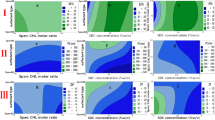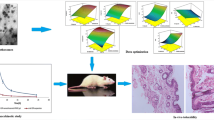Abstract
Purpose
Tizanidine (TZN) is used for the management of muscle spasms. Oral TZN is liable to first-pass metabolism and interindividual variation. Transdermal drug delivery systems (TDDS) are gaining research attention as an alternative route. The aim of this study is the bioanalytical comparison of the oral route and two TDDS, bilosomes and aspasomes.
Methods
TZN-loaded bilosomes and aspasomes were applied to mice. The plasma concentration of TZN was determined in mice plasma post application by in-house developed HPLC method. Results were compared to those obtained post an equal oral dose. Pharmacokinetic parameters were deduced and statistically compared.
Results
The TDDS route significantly enhanced the bioavailability and plasma concentration of TZN (p < 0.0009; CL = 95). The drug half-life (t1/2) significantly increased (< 0.0001; CL = 95) when using the TDDS instead of the oral route. Among the TDDS vesicles, the bilosomes significantly enhance bioavailability and Cmax over aspasomes (p < 0.0316; CL = 95). Both vesicles were not statistically different in terms of extending the drug half-life.
Conclusions
In conclusion, the bioanalytical comparison revealed that the TDDS can overcome the first-pass effect of TZN and enhances its bioavailability over the oral route. Bilosomes were more efficient than aspasomes for enhancing the TZN bioavailability. Both vesicular formulas were equivalent for extending the half-life of the drug.



Similar content being viewed by others
References
Farrell MC, Biaggioni I, Shibao CA. Neurogenic orthostatic hypotension induced by tizanidine. Clin Auton Res. 2019:1–3.
Simpson S, Huycke LI. Multiple sclerosis—what occupational health nurses need to know. AAOHN J. 2006;54(11):469–78.
Granfors MT, Backman JT, Neuvonen M, Ahonen J, Neuvonen PJ. Fluvoxamine drastically increases concentrations and effects of tizanidine: a potentially hazardous interaction. Clin Pharmacol Ther. 2004;75(4):331–41.
Zhou S-F, Wang B, Yang L-P, Liu J-P. Structure, function, regulation and polymorphism and the clinical significance of human cytochrome P450 1A2. Drug Metab Rev. 2010;42(2):268–354. https://doi.org/10.3109/03602530903286476.
Wagstaff AJ, Bryson HM. Tizanidine. Drugs. 1997;53(3):435–52. https://doi.org/10.2165/00003495-199753030-00007.
Nance PW, Sheremata WA, Lynch SG, Vollmer T, Hudson S, Francis GS, et al. Relationship of the antispasticity effect of tizanidine to plasma concentration in patients with multiple sclerosis. Arch Neurol. 1997;54(6):731–6. https://doi.org/10.1001/archneur.1997.00550180049011.
Emre M, Leslie GC, Muir C, Part NJ, Pokorny R, Roberts RC. Correlations between dose, plasma concentrations, and antispastic action of tizanidine (Sirdalud). J Neurol Neurosurg Psychiatry. 1994;57(11):1355–9. https://doi.org/10.1136/jnnp.57.11.1355.
Henney HR III, Runyan JD. A clinically relevant review of tizanidine hydrochloride dose relationships to pharmacokinetics, drug safety and effectiveness in healthy subjects and patients. Int J Clin Pract. 2008;62(2):314–24. https://doi.org/10.1111/j.1742-1241.2007.01660.x.
Backman JT, Schröder MT, Neuvonen PJ. Effects of gender and moderate smoking on the pharmacokinetics and effects of the CYP1A2 substrate tizanidine. Eur J Clin Pharmacol. 2008;64(1):17–24.
Thakkar H, Pandya K, Patel B. Microneedle-mediated transdermal delivery of tizanidine hydrochloride. In: Jain KK, editor. Drug Delivery Systems. New York, NY: Springer New York; 2020. p. 239–58.
Khalil RM, Abdelbary A, Kocova El-Arini S, Basha M, El-Hashemy HA. Evaluation of bilosomes as nanocarriers for transdermal delivery of tizanidine hydrochloride: in vitro and ex vivo optimization. J Liposome Res. 2019;29(2):171–82.
Khalil RM, Abdelbary A, Kocova El Arini S, Basha M, El-Hashemy HA, Farouk F. Development of tizanidine loaded aspasomes as transdermal delivery system: ex-vivo and in-vivo evaluation. J liposome Res. 2019 (Published online: 08 Nov 2019):1–36.
Nirogi RV, Kandikere VN, Shukla M, Mudigonda K, Maurya S. Quantification of tizanidine in human plasma by liquid chromatography coupled to tandem mass spectrometry. Rapid Commun Mass Spectrom. 2006;20(15):2286–92.
Ulu ST. Sensitive spectrofluorimetric determination of tizanidine in pharmaceutical preparations, human plasma and urine through derivatization with dansyl chloride. Luminescence. 2012;27(5):426–30. https://doi.org/10.1002/bio.1367.
Khalil RM, Abdelbary A, Arini SKE, Basha M, El-Hashemy HA, Farouk F. Development of tizanidine loaded aspasomes as transdermal delivery system: ex-vivo and in-vivo evaluation. J Liposome Res. 2019:1–11.
Use CfMPfH. Guideline on bioanalytical method validation. European Medicines Agency EMEA: CHMP/EWP/192217/2009, 1–22. (cited 2011 August 01). Available from: www.ema.europa.eu/ema/pages/includes/document/open_document.jsp.
Silvia RMKAA, Hadeer KEAMB, Faroukc AE-HF. Development of tizanidine loaded aspasomes as transdermal delivery system: ex-vivo and in-vivo evaluation
Ahuja S, Dong M. Handbook of pharmaceutical analysis by HPLC: Elsevier; 2005.
Granfors MT, Backman JT, Laitila J, Neuvonen PJ. Tizanidine is mainly metabolized by cytochrome P450 1A2 in vitro. Br J Clin Pharmacol. 2004;57(3):349–53. https://doi.org/10.1046/j.1365-2125.2003.02028.x.
Pavlović N, Goločorbin-Kon S, Ðanić M, Stanimirov B, Al-Salami H, Stankov K, et al. Bile acids and their derivatives as potential modifiers of drug release and pharmacokinetic profiles. Front Pharmacol. 2018;9(1283). https://doi.org/10.3389/fphar.2018.01283.
Author information
Authors and Affiliations
Corresponding author
Ethics declarations
Conflict of Interest
The authors declare that they have no conflict of interest.
Ethical Approval
All applicable international, national, and/or institutional guidelines for the care and use of animals were followed.
Additional information
Publisher’s Note
Springer Nature remains neutral with regard to jurisdictional claims in published maps and institutional affiliations.
Rights and permissions
About this article
Cite this article
Farouk, F., Khalil, R.M., Abdelbary, A. et al. Bioanalytical Comparison of Transdermal Delivery of Tizanidine from Different Nanovesicular Carriers. J Pharm Innov 16, 384–390 (2021). https://doi.org/10.1007/s12247-020-09447-z
Published:
Issue Date:
DOI: https://doi.org/10.1007/s12247-020-09447-z




